Audio Processing and Compressors for Your Station!
Q. Why do I need audio processing for my station? Do I need a compressor? Or a limiter? Or a clipper? Or a Multiband audio processor? Or something with Automatic Gain Control? And does a $2000 audio processor sound 10 times better than a $200 compressor?
One of your most important duties as a low power fm operator is making sure that the sound that you send from your studio into the transmitter is within the limits of volume set by the FCC. Your transmitter will set up a “carrier” signal that runs at your frequency. The carrier, running on your frequency, is what makes you distinct from other radio stations. You may have a carrier signal that is 91.3, while your nearest neighbor on the dial may be 91.7. You will add audio on top of that from your mixing board. Then the listener can hear your audio by tuning to your carrier frequency at 91.3 on the dial, and they can listen to your neighbor by tuning to 91.7.
The louder you turn up the volume at your mixing board, the more you modulate the signal, and the louder it gets for the listener. Up to a point, that is good so that you are not dramatically louder than anything else. However, there is only so loud that you can turn up your audio before the kettle boils over onto your neighbors carrier. The FCC has rules about exactly how loud (and how soft) you can be. Radio stations generally have modulation monitors, which help you calibrate your equipment and monitor your levels. They also have some form of audio processing, which take the raw audio from out of the mixing board and at least make sure that it does not exceed FCC specifications. Fancier models, that cost more, can create an array of effects that can make your station sound better. The following piece will introduce several concepts: limiting, compressing, clipping and automatic gain control. A compressor is a piece of equipment which can create a number of these effects on audio.
And we’ll look at some of the controls of a compressor, which include attack, release, ratio and threshold:
The diagrams below are visual representations of real audio clips, intended to show you what actual waveforms look like. Here are the unprocessed, natural waveforms:
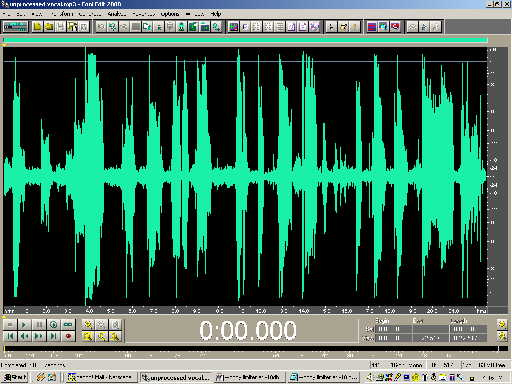
Here is Radio Volta’s Dr. Sunup talking: Surprise peaks are the norm. Usually they are brief.
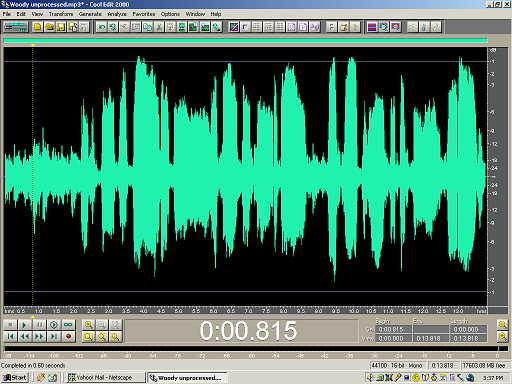
Here is some unprocessed music- in this case, Woodie Guthrie singing and playing guitar.
Most of the rest of this answer courtesy of John Shwenk, Engineer for WHUS-FM in Connecticut- we thank him for his valuable insights.
Limiting and Clipping
Limiting and clipping are related. The distinction involves the fact that a level adjustment with a time constant is involved in limiting but not in clipping.
Limiting drags the fader down (imagine an invisible fader internal to the limiter) to anticipate future peaks when the level exceeds the THRESHOLD and the fader is only slowly allowed to come back up (set by the RELEASE control). Clipping doesn't change the fader level. It just shears off the waveform. And during the next cycle or peak, it gets sheared again... and again. There is no pulling down of the imaginary fader to prevent future shearing, and no release (or recovery) time.
More detail:
Clipping is an instantaneous shearing off of waveform peaks that occurs when the intantaneous signal level exceeds (in either the + or - direction) the voltage that a given piece of equipment can pass (or is set to pass). When you look at the waveform, it looks like the mesas in Arizona. Flat topped hills. The waveform wanted to go higher (it did go higher before it hit the circuit that's clipping it) but it was prevented from doing so and the output of the circuit simply remains at the highest voltage it can put out while the input is above the clipping level (hopefully! - some circuits do even worse sounding things when they're clipped).
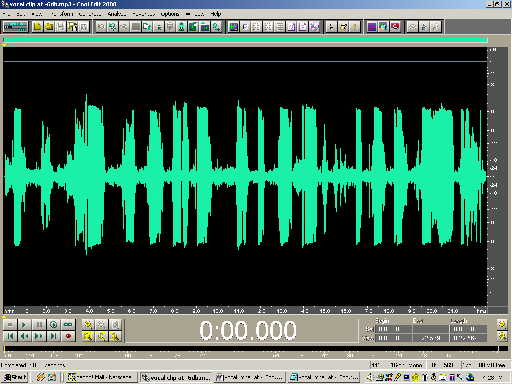
Effective, but rather abrupt sounding compression of the talking sample.
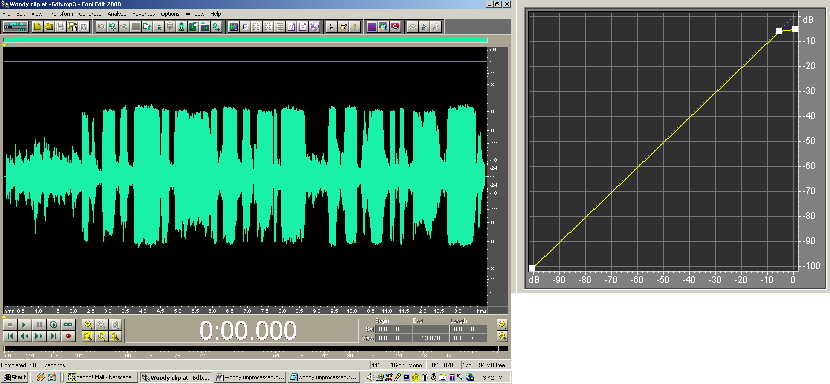
This is the "brick wall" clipper at -6db om the music. It will keep your signal safe from clipping distortion, but the sound is very abrupt to some ears.
Distortion
Clipping is the most commonly heard kind of distortion (clipping distortion) and is very objectionable on voice and other monotonic (one tone or sound at a time) sounds. A similar amount of clipping distortion applied to some kinds of music is not quite as audible but is still a problem. Even amounts that are not explicitly noticeable to a given listener will still lead to greater listener fatigue. They may not know why they don't want to listen any more but it happens nevertheless.
Individuals vary in their ability to hear distortion (or at least to identify what they're hearing). I'm often surprised when others claim not to be able to hear the problem that I'm finding so objectionable I need to turn the radio off!
Limiting, revisited
First of all, limiting is a kind of compression. It is compression with the RATIO control set to infinity to 1 ratio. This causes the compressor to turn the level down (using its internal electronic fader) as much as is required to prevent the overall signal level from exceeding the threshold (set by the THRESHOLD control). When the input level drops back below the threshold, the fader starts to rise back up again at a rate set by the RELEASE control until another peak exceeds the threshold and the fader is forced down again.
Limiting refers to the fact that the output level of the unit is limited to that of the THRESHOLD setting. That's the case when the RATIO is set to infinity to 1. If the RATIO was set to 2 to 1, for instance, the output level would be allowed to rise 1 db over the THRESHOLD when the input level went 2 db over. The output would rise 5 db when the input rose 10 db, etc. Infinity to 1 ratio - limiting - makes it so that, not matter how much the input level rises, the internal fader is lowered enough to prevent the output from rising at all.
This state of affairs is similar to clipping - hence the confusion. With clipping, the output is also prevented from rising above a threshold level. But its not because a circuit effectively lowered a fader but because the circuit simply sheared off the intantaneous waveform peak.

The limiter alone doesn't do the whole trick here, but it helps give a more natural sound to Dr. Sunups voice. Compressors reduce not only the top dynamic range, but also allow the quieter passages to become louder, thus reducing the dynamic range on both ends. Some ears perceive this as "breathy" on vocals and "muddy" on music. Using a limiter, with a clipper at a slightly higher threshold, gives a smooth enough curve to keep things pleasant to listen to.
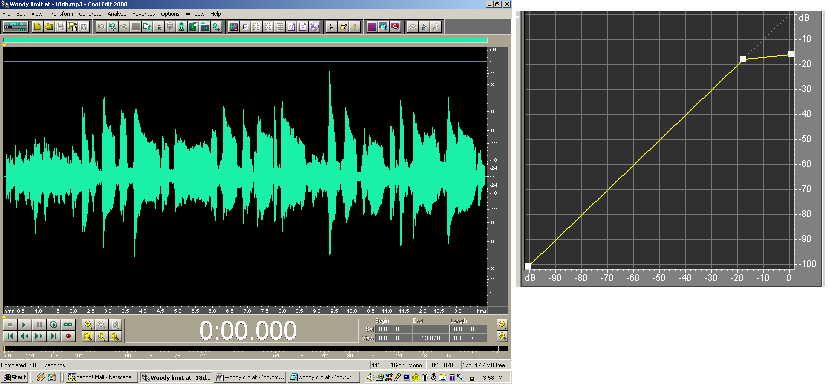
Here is the music with a limiter at -18db. With the slow attack and release time, it is more natural sounding than the hard clipper. Usually, the peaks are long enough to trigger the limiter: but sometimes the transient peaks are shorter than the attack time.
Compressor Controls, and Automatic Gain Control (AGC)
Another related issue I want to mention is the ATTACK control on most compressors. That's the rate at which the internal fader is allowed to respond to the peak; how fast it gets pulled down. So ATTACK is how fast it gets pulled down, RELEASE is how fast it's allowed to rise back up. It the ATTACK is slow, a fast peak will slip through the compressor. The fader didn't react fast enough to bring the level down. However, a sustained high signal level will allow a compressor with a slow ATTACK setting to respond and bring down the fader to compensate.
Different settings for ATTACK, RELEASE, THRESHOLD, and RATIO are used for different purposes and can be called by different names.
Limiting refers to fast ATTACK and infinity to 1 RATIO.
AGC generally refers to a very slow ATTACK and RELEASE. Imagine a very sleepy or lazy person sitting at the board, slowly riding the fader to compensate for level variations in the signal.
Now, try to grok this:
Clipping can be viewed as compression/limiting with instantaneous (infinitely fast) ATTACK and RELEASE and infinity to 1 RATIO.
If you understand that statement, you now fully understand this stuff.
Limiting and Clipping, one more time
The reason you want both limiting and clipping in an FM audio processor is this:
The limiter is needed to control the level and do most of the job of preventing overmodulation. However, most limiters have a finite, if small, attack time constant; they don't instantaneously respond to peaks. Many also do not have perfect compression ratios of infinity to 1. That is, the output is still allowed to rise a little even when the input exceeds the threshold and especially when it exceeds it quickly. Thus, a clipper is needed as the very last stage to absolutely guarantee FCC compliance. The clipper will just shear off any errant waveform peak that makes it through the other stages, preventing overmodulation.
Most FM audio processors purposely reduce the attack rate or the compression ratio on the limiter stage and/or increase the limiter threshold so that some clipping will occur in the clipper stage. Yes, this causes clipping distortion, especially on fast attacks and narrow peaks. But it also raises average volume level. Up to a point, the more you clip, the louder you'll sound because the average level to peak level ratio is increased.
That's the critical adjustment I referred to previously and where the loudness vs. distortion compromise comes in.

With the limiter AND the clipper, there is a natural sounding compression - with a safety net on Woody’s music.
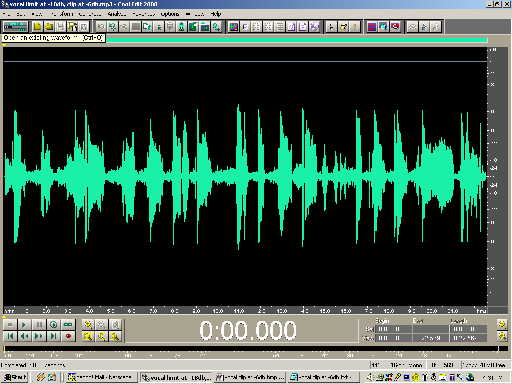
As with music, a pleasant style of compression that also prevents clipping distortion in Doctor Sunups ill-chosen words. The typical two-channel compressor/limiters commonly found in live sound and recording studios generally cost $100 to $200. For the limiting and clipping, the outputs of one channel (set as a limiter), can be wired to the inputs of the other channel (set as a clipper. Some units offer a peak limiter (also known as a clipper) in each channel in addition to the full set of parameters for other compression purposes. If this is the case, you need use only one channel. Simply set the threshold of the peak limiter (the only parameter offered) slightly higher than the limiter.
So, what is the difference between a cheapo compressor and a multiband audio processor?
A multiband audio processor basically includes several different compressors, which each have different settings for the low, medium and high frequency components of the program audio. This allows each of the compressor settings to be more subtle and boost the loudness of the low and medium frequency tones more than the high tones. The high frequency tones cause modulation problems at lower volumes, so overall loudness can be legally boosted if the frequencies are treated separately. Most commercial stations use very aggressive multiband processing. Try listening to a classic rock song on a CD, and then listen to it on the radio and you will hear the difference.
Loudness does not correlate that much to listenable range for FM. Certainly it's a matter of degree. Increased loudness will always give you increased signal to noise ratio (SNR) at any range, but as a gross general statement, a station either comes in well enough to listen to, or it doesn't, regardless of it's loudness. (This is an entirely separate matter for AM.)
Some people can not hear any of this. But some people who listen carefully can be driven absolutely batty by overprocessed sound. Many do not even notice but they find that their ears are tired when they listen to overprocessed commercial radio. Because they push everything to be maximum volume at all time to bust over the sound of drills at a construction site or the traffic noise on the freeway, the programming lacks the soft spots that we find in natural unprocessed listening.
There is just one important issue which sets most commercially available compressor limiters used by musicians from professional broadcast boards. This issue is Pre-emphasis. All FM transmitters have a special circuit that adds a special boost to the higher frequency parts of the audio, and all FM receivers have a little circuit that takes that boost back out. This helps improve the signal to noise ratio. If your compressor does not take into account this “pre-emphasis” all hell can break loose. Broadcast compressors take this into account. Music compressors generally do not.
There are a few of the English radio companies that build cheap compressors that have pre-emphasis circuit. You can check out broadcast warehouse (http://www.broadcastwarehouse.com) or veronica (http://www.veronica-kits.co.uk/). We have not tested these yet, but will soon. Ask for a 75 microsecond pre-emphasis- that is the US standard.
If they turn out to work, a best bet would be to use one of the english compressors, plus a cheapo compressor musician compressor like the ones from behringer. A good source is www.progressive-concepts.com These range from $100 to $200. Set it for hard limiting - infinity to 1 compression ratio (or as high as it goes) with a fast attack. Of course, you need a clipper following it. You can set up a Behringer for that.
The level adjustment following the compressor, driving the clipper, will be a critical one. Higher gives you more apparent loudness but with increased distortion.
Yes, you would get somewhat more loudness with a $2000 box over a $200 box, but you certainly won't get 10 times the loudness! Maybe you'd get on the order of 2 or 3 db more. (A total guess). It is probably not worth it except for operations with large budgets. There are just too many other things to spend that money on! Meet all the other stations numerous needs, then revisit the audio processor issue when there's extra money in the budget. (Hah!)
How all this relates to Mixing Boards
Broadcast consoles are designed for broadcast use, and have special features designed for taking phone calls, turning down the monitors when the mics go on, etcetera. DJ mixers are designed for recording or contolling a live show. They are much cheaper and more common and can do a decent job in a radio studio, but have a few design limitations that make them less than optimal if you can afford to choose.
A good example of a relatively inexpensive pro control board intended for broadcast use is the "Blue" from LPB. But, given that most LP stations are going to run in mono anyway (Blue is a stereo board like most modern broadcast boards), the small recording boards and DJ-type mixers are probably the best bet except for stations with big budgets (for an LPFM).
Old broadcast boards are often a very good deal. Because so many radio stations are going digital now, their giant old clunky boards are being dumped on the market for less than they are worth. They may need some work, but broadcast boards are one of the places where second hand can make sense if the equipment was built well to start with.
Here’s another related issue that plagues some of our staff members at U Conn's radio station, WHUS. It's that some DJs just seem untrainable as far as setting levels is concerned. It's all nice and good to have an audio processor that keeps the station from overmodulating (keeps it legal), but it doesn't help if the DJ has their level way too low or too high. If it's too low, the station will be quiet. If it's too high, they'll clip in the mixer before the signal can even get to the audio processor!
This is usually handled with some kind of automatic gain control (AGC) between the mixer and the audio processor. It can be built in to the audio processor as the first stage. The AGC can raise the level slowly to compensate for the DJ setting their fader too low or for quiet musical passages. The problem with this scheme is that it can't help if the DJ sets their level too high. The control board will still clip before the signal gets to the AGC. It's assumed that your DJs are professionally trainable to set and watch their levels properly. This seems to be an incorrect assumption with college and community radio.
The ideal solution may not exist as a commercial product. That's to have the AGC built in to the mixer! That way, you wouldn't be able to clip the mixer. Its built-in AGC would compensate for poorly set faders / trims controls. (I've been considering modifying our control board to do just that.) The feature could have a defeat switch so that competent DJs could run without the AGC.
Entrepreneurs take note: there's a market for a mixer/processor specifically designed to meet the needs of LPFM, micro, and college radio. It would be an all-in-one mono mixer, AGC, limiter, clipper, that is simple to use, physically robust, and not too expensive. A fool-proof device.
